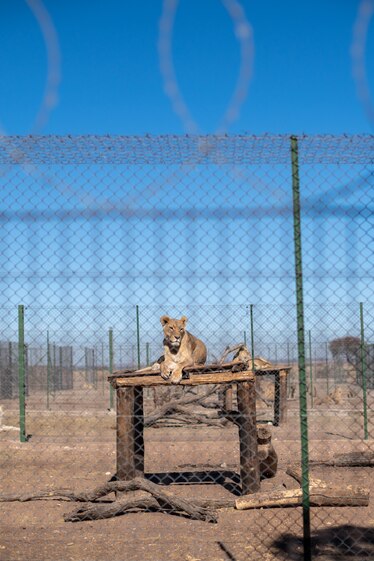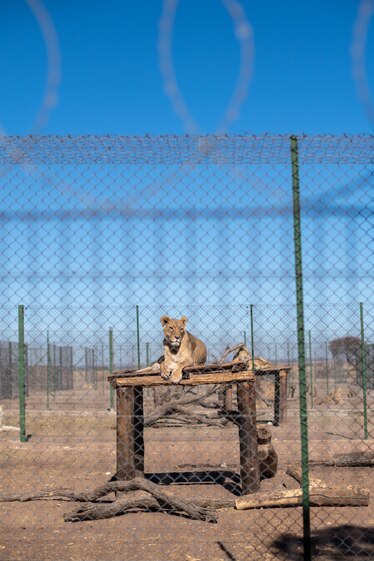A new gene study has cast doubt on the commonly held belief that South Africa’s captive lions are inbred. Although the study found that the lions were closely related, it concluded that they were not inbred. Inbreeding in captive lions has long been a concern due to poorly managed breeding programs, which can result in health issues and abnormalities. The study compared the gene profiles of captive lions with those of wild lions and found them to be comparable. Additionally, the study revealed signs of genetic drift, indicating that captive lions do not preserve the genetics of their wild counterparts. In response to ethical concerns and the risk of disease, the South African government has announced plans to shut down the captive lion industry. While some argue for the possibility of reintroducing captive lions into the wild, critics believe the risks, such as disease transmission and potential attacks on humans or livestock, make this an unlikely and dangerous endeavor.

Background
In South Africa, there has been a longstanding belief that captive lions are the product of inbreeding. This belief has raised concerns about the health and well-being of these animals, as inbreeding can lead to a variety of health issues and abnormalities. These concerns are further fueled by poorly managed breeding programs in the country.
The New Gene Study
However, a recent gene study challenges this belief. The study found that while the captive lions studied were not inbred, they were indeed closely related. This means that there is a degree of genetic similarity among the captive lion population in South Africa.
To determine the extent of this genetic relatedness, the study compared the genotypes of captive lions to those of wild lions. Surprisingly, the study found that the genotypes of captive lions were comparable to those of their wild counterparts. This suggests that the captive lion population still retains a significant amount of genetic diversity.
Additionally, the study identified signs of genetic drift in the captive lions. Genetic drift refers to the random changes in gene frequencies over time. This suggests that the captive lion population is not preserving the genetics of wild lion populations and may be undergoing its own unique evolutionary process.
Implications and Concerns
These findings have significant implications for the captive lion industry in South Africa. The government has already announced plans to shut down this industry due to ethical concerns and the risk of disease. The belief in widespread inbreeding has only added fuel to this decision.
Ethical concerns surrounding the captive lion industry stem from the belief that lions should not be bred and kept in captivity for commercial purposes. Many organizations and individuals argue that these magnificent animals should be allowed to live freely in their natural habitats rather than being confined for human entertainment.
Furthermore, the risk of disease is a major concern associated with the captive lion industry. Close quarters and potentially unsanitary conditions can create an environment ripe for the spread of infectious diseases. This not only threatens the health of the captive lions themselves but also the human handlers and visitors who come into contact with them.
Unlikelihood of Successful Reintroduction
Some proponents of the captive lion industry argue that these animals could potentially be reintroduced into the wild. However, critics believe that this is unlikely to be successful. The reasons for this skepticism are rooted in the concerns surrounding the genetic makeup of captive lions.
Genetic diversity is crucial for the survival and adaptability of a species. Inbreeding and genetic drift can lead to reduced genetic diversity, making a population more susceptible to disease and less able to adapt to changing environments. As the captive lion population in South Africa is closely related and shows signs of genetic drift, reintroducing them into the wild could have serious implications for the long-term survival of the species.
Risks of Releasing Captive Lions
Releasing captive lions into the wild poses several risks that cannot be ignored. One of the main concerns is the spread of disease. Captive lions, especially those from poorly managed breeding programs, may already be carrying diseases that could be easily transmitted to wild populations. This could have devastating consequences for the overall health and stability of wild lion populations.
Another risk is the potential for attacks on humans or livestock. Captive lions are often raised and conditioned in environments where they have regular interactions with humans. Releasing them into the wild could disrupt their behavior, potentially leading to aggressive and dangerous encounters with humans or livestock. This poses a significant threat to the safety and livelihoods of local communities.
In conclusion, while the recent gene study has shed light on the genetic makeup of South Africa’s captive lion population, there are still concerns surrounding the ethics and risks associated with the industry. The findings suggest that these lions are closely related but not necessarily inbred. However, the South African government’s plans to shut down the captive lion industry reflect the larger concerns of ethical treatment and disease transmission. Additionally, the unlikelihood of successful reintroduction into the wild highlights the challenges posed by the genetic makeup of captive lions. Ultimately, the risks associated with releasing captive lions, such as the spread of disease and potential attacks on humans or livestock, cannot be ignored.

